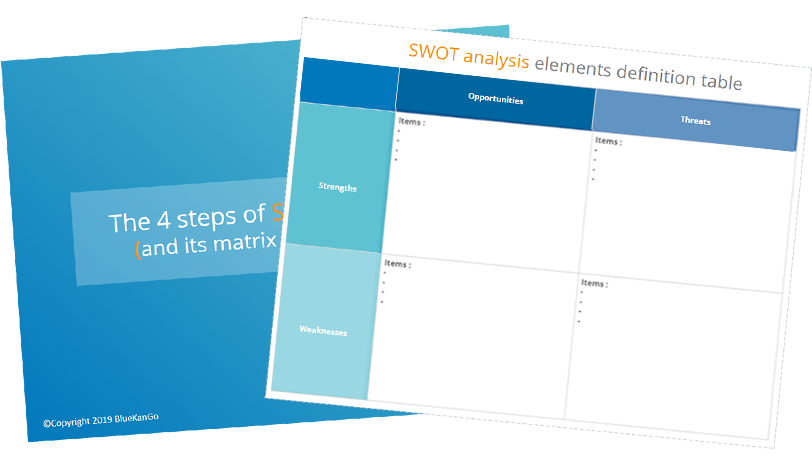
SWOT analysis - Strength, Weaknesses, Opportunities, Threats - is a strategic analysis tool. It combines the analysis of an organization's strengths and weaknesses with that of the threats and opportunities of its external environment to define strategies to better achieve its objectives/missions.
All the components of the SWOT analysis
An organization's ability to carry out their missions can be divided into strengths and weaknesses:
- Strengths are the positive internal aspects controlled by the organization, which give them a sustainable advantage and positively affect their performance (the company's Quality Policy for example).
- Weaknesses are the negative internal aspects controlled by the organization, which negatively affect their performance and for which there is significant room for improvement (e. g. a high absenteeism rate for example).
The company may be affected by risks related to the external environment. These are defined as "the effect of uncertainty" by ISO 9000:2015.
They are divided into opportunities and threats:
- Opportunities represent positive external factors or occasions that the organization can take advantage of to improve their performance (changing regulatory environment or opening up new opportunities for example).
- Threats are external obstacles, problems or limitations that can affect the company’s performance (e. g. resources decrease).

Recommended for you. Download the guide: “The 4 steps of SWOT analysis and its matrix” for free.
Why do a SWOT analysis?
SWOT analysis is a strategic management tool that is experiencing a renewed interest with the publication of the ISO 9001:2015 standard for quality management systems: risk and opportunity analysis is one of the main new features of this 2015 version.
The new standard requires to consider the issues, risks and opportunities in the organization's environment and in the quality management system (QMS) that could affect compliance.
The SWOT analysis’ steps
1) Conduct a document review
This study will allow the SWOT analysis organizer to familiarize himself with the organization's missions and the areas chosen for the study, and to prepare the SWOT analysis meeting: this preparation can take about 2 days. The organizer could be internal staff (e. g. the quality manager) or external (an expert consultant).
2) Define the framework for the analysis
It is all about defining the strategic field of activity to be studied.
Let's take the example of an ISO 9001 certified organization that has decided to use the SWOT analysis to meet the requirement to analyze its context. They divided their activities into three strategic areas:
- expertise ;
- international action ;
- market surveillance.
Support services is the fourth area studied.
The next step is to assign each area of study to a working group that will be led by one of its members, usually the director or department head responsible for the field concerned. Each working group will bring together people who are directly involved in the relevant field. Ideally, a SWOT analysis working group should consist of about 6 people.
A location is chosen, preferably outside the organization to avoid disturbing participants with their daily obligations.
When introducing the session, the organizer presents the SWOT analysis, establishes the link with the ISO 9001:2015 standard requirements (if the organization is aiming for this certification), details the working method and the day's agenda. He then uses his knowledge of SWOT analysis and the document review he has previously worked on in order to supervise the work of the participants.
3) Identify strengths, weaknesses, opportunities and threats
The organizer asks each working group to define 3 to 5 SWOT items in each of the 4 components (strengths, weaknesses, opportunities, threats). The items identified by each group on their field of study should be based on incontrovertible evidence or facts and then prioritized in order of importance. Evidence can be obtained from a variety of sources (benchmarking, external or internal audits, reports, objective facts, figures, etc.).
This analysis takes each group about an hour.
4) Define strategic priority options
After each group has identified the elements in each of the components, the next step is then to cross-reference these elements to define priority strategic options. This analysis should take about 2 hours for each group.
Among all the strategic options reported in the strategic analysis grid, each working group selects those that they consider to be priorities (4 or 5 in general). The selection criteria are generally as follows: contribution to the organization's missions and expected performance, ease of implementation, etc. All this work is presented by each group for half an hour per group (15 minutes of presentation and 15 minutes of Q&A session).
5) Write the final report
The organizer writes the final report in the following days, including the strong arguments provided by the groups to justify their analysis.
In this report, he also gives his opinion on the quality of the analysis and any additional work to be carried out, based on his observations and the SWOT analysis evaluation grid.
Thus, the SWOT analysis will be all the better carried out if the following instructions are respected by the working groups: respect for everyone's speaking time, constructive criticism, consensus building. SWOT analysis identifies priority options at the level of each strategic area studied and at the organization level. They are then deployed as an action plan and implemented in the departments.
To help you, I recommend this guide that we came up with which includes the 4 steps to do your SWOT analysis and a template to download in PPT format.
. . .





